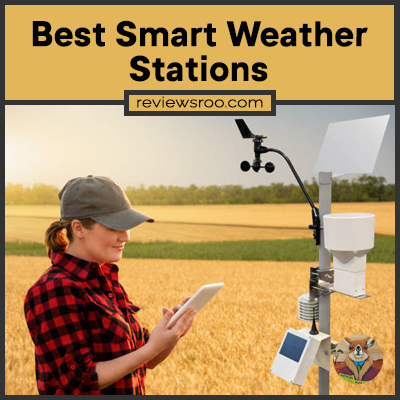Best Smart Weather Stations
It’s a timeless struggle: every day, we battle the weather. We can never predict it, and it’s always changing. We often don’t know what to expect from one moment to the next. But now there’s a way to get a leg up on Mother Nature: the best smart weather stations.

These devices give you an accurate picture of your local conditions in real-time. They can measure temperature, humidity, air pressure and more – all from the comfort of your own home. You’ll have an advantage over anyone else who isn’t using one!
With so many smart weather stations on the market, it can be hard to choose the right one for you. That’s why we’ve put together this list of the best ones available today – so you can make an informed decision and stay ahead of unpredictable weather patterns.
Top Pick: Comprehensive and Accurate Weather Station
I recently purchased the ECOWITT Weather Station Powered by Solar Energy with Weather Forecast, and I am highly impressed with its comprehensive features and accurate weather monitoring capabilities.
Solar-Powered and Eco-Friendly: This weather station stands out for its solar-powered design, reducing the need for batteries and making it an environmentally friendly choice. The solar panel efficiently harnesses sunlight to power the station, ensuring continuous operation and sustainability.
Detailed Weather Monitoring: With this weather station, you can access a wealth of weather information right at your fingertips. From real-time temperature and humidity measurements to barometric pressure trends and weather forecasts, this device provides comprehensive and reliable data to satisfy the curiosity of weather enthusiasts.
Easy-to-Read Display and User-Friendly Interface: The weather station features a clear and intuitive display, making it easy to read and interpret the weather data. The user-friendly interface ensures a smooth navigation experience, allowing users of all levels to effortlessly access the information they need.
Pros:
- Accurate Weather Monitoring
- Solar-Powered Convenience
- Comprehensive Weather Information
Cons:
- Limited Connectivity
- Complex Setup
Comprehensive Wireless Weather Station
I recently purchased the ECOWITT WH2910C Weather Station with Wireless Sensor and Forecast, and I am extremely satisfied with its comprehensive features and accurate weather forecasting capabilities.
Wireless Sensor and Transmission: This weather station sets itself apart with its wireless sensor, allowing for easy installation and placement flexibility. The wireless transmission ensures seamless communication between the sensor and the main unit, providing real-time weather data without the hassle of wires.
Accurate Weather Forecasting: With the ECOWITT WH2910C, you can rely on its accurate weather forecasting capabilities. The station utilizes advanced technology to analyze weather patterns, providing reliable forecasts that help you plan your activities with confidence.
User-Friendly Interface and Customizable Alerts: The weather station features a user-friendly interface that makes it easy to navigate and access the wealth of weather information it provides. Additionally, users can set customizable alerts for specific weather conditions, keeping them informed and prepared for any changes.
Pros:
- Comprehensive Weather Data
- Accurate Forecasting
- Wireless and Convenient
Cons:
- Learning Curve
- Limited Connectivity
Advanced and Reliable Weather Station
I recently purchased the Ambient Weather WS-1550-IP Weather Station with Internet Monitoring, and I am extremely impressed with its advanced features and reliable weather monitoring capabilities.
Internet Connectivity and Remote Monitoring: This weather station stands out with its internet connectivity, allowing users to remotely access and monitor weather data from anywhere. The ability to view real-time weather conditions and historical records through online platforms adds convenience and flexibility to the user experience.
Comprehensive Weather Data and Graphical Display: The Ambient Weather WS-1550-IP provides a wealth of weather information, including temperature, humidity, wind speed and direction, barometric pressure, rainfall measurements, and more. The graphical display presents the data in a clear and visually appealing format, enhancing readability and analysis.
Easy Installation and Setup Setting up: The Ambient Weather WS-1550-IP is a breeze, thanks to its straightforward installation process. The user-friendly interface and intuitive menu make it easy to configure settings and customize the display to suit individual preferences.
Pros:
- Internet Connectivity and Remote Monitoring
- Comprehensive Weather Data
- Graphical Display
Cons:
- Complex Configuration for Internet Connectivity
- Limited Connectivity with External Devices
Highly Reliable and Professional Weather Station

I recently purchased the Professional Weather Station with AccuWeather Forecast, and I am extremely pleased with its professional-grade features and accurate weather monitoring capabilities.
Accurate and Detailed Weather Forecast: This weather station excels in providing highly accurate weather forecasts, thanks to its partnership with AccuWeather. Users can rely on the forecast data to plan their activities with confidence, knowing they have access to reliable predictions.
Comprehensive Weather Monitoring and Analysis: With the Professional Weather Station, you can gather a wealth of data to monitor and analyze weather conditions. From temperature and humidity to wind speed and direction, rainfall measurements, and more, this station offers a comprehensive suite of features for in-depth weather monitoring.
User-Friendly Interface and High-Quality Display: The weather station features a user-friendly interface that makes it easy to navigate and access the array of weather data it provides. The high-quality display ensures clear visibility and readability, allowing users to quickly and efficiently interpret the information.
Pros:
- Accurate Weather Forecasting
- Comprehensive Weather Data
- User-Friendly Interface and Display
Cons:
- Installation Complexity
- Limited Connectivity and Integration
Advanced and Feature-Rich Weather Station
I recently purchased the Ambient Weather WS-2000 Weather Station with Internet Monitoring, and I am thoroughly impressed with its advanced features, comprehensive monitoring capabilities, and reliable performance.
Internet Connectivity and Remote Monitoring: This weather station excels in its internet connectivity feature, allowing users to access real-time weather data and historical records remotely. The ability to monitor weather conditions from anywhere adds convenience and flexibility to the user experience.
High-Resolution Color Display and Graphical Data Presentation: The WS-2000 boasts a high-resolution color display that enhances readability and visual appeal. The graphical presentation of weather data provides a clear and intuitive representation, making it easier to analyze and interpret the information.
Extensive Sensor Array and Accurate Measurements: With an extensive sensor array, the WS-2000 provides comprehensive monitoring of weather conditions. From temperature and humidity to wind speed and direction, rainfall measurements, UV index, and more, this weather station offers accurate and reliable measurements for a complete weather overview.
Pros:
- Internet Connectivity and Remote Monitoring
- High-Resolution Color Display
- Comprehensive Sensor Array
Cons:
- Complex Setup
- Limited Compatibility
Overview Of Smart Weather Stations
Smart weather stations are like a breath of fresh air for meteorologists. They provide an array of data points that can be used to accurately forecast the weather in any given location. The first paragraph will provide an overview of what these devices are and how they work, while the second will discuss their benefits.
A smart weather station is a device consisting of sensors, transmitters and receivers, which measure temperature, rainfall, wind speed and other atmospheric parameters in real-time. These measurements are then transmitted to a central computer for analysis and broadcasting. This enables meteorologists to create accurate forecasts based on the data gathered from these stations.
In addition to providing accurate readings, these stations also help reduce the cost associated with manual observation and data collection. Smart weather stations are also equipped with wireless communication capabilities so they can be monitored remotely without requiring additional infrastructure. This makes them ideal for remote locations where traditional methods would not be practical or feasible.
Benefits Of Using A Smart Weather Station
It’s like a superpower; the ability to predict the weather with absolute accuracy. Smart weather stations are just that – they give you the power of predicting, tracking and measuring temperature, humidity, wind speed and other metrics with great precision.
These devices come with a range of benefits that make them invaluable for those looking to stay ahead of the elements. Let’s take a look:
- Accuracy: Smart weather stations are precise in their measurements and readings, ensuring you get dependable data every time.
- Convenience: With a smart weather station at your disposal, you no longer have to wait for an official report from the local meteorological office as you can access real-time updates anytime and anywhere.
- Cost-effective: Investing in a smart weather station is far more economical than relying on manual or web based services for collecting meteorological data.
A smart weather station is an effective way to stay one step ahead of Mother Nature. It requires minimal effort, offers accurate readings and is cost-effective too – what more could one ask for? All that’s left now is understanding which features are important when looking for the best smart weather station.
Features To Look For In A Smart Weather Station
Smart weather stations are a great way to monitor your area’s weather. They provide useful information for those who want to know the conditions of the day or week. But what features make a good smart weather station?
The most important feature is accuracy. A reliable weather station will give you accurate readings on temperature, humidity, and wind speed. You should also look for one that has a wide range of sensors so that it can provide detailed data about the conditions in your area. Some models come with advanced features like air quality monitoring and lightning detection, which can help you stay informed of dangerous weather events. Additionally, look for models with intuitive interfaces so you can easily access the data it collects. This will make it easier for you to analyze and use the information provided by the station.
Your choice of smart weather station should be based on what type of data you need and how much detail you want to receive from it. Make sure to consider these factors before buying one so that you get the best results from your purchase.
Comparison Of Popular Smart Weather Stations
Which one should you buy? With so many options on the market, it can be hard to decide. This section will compare some of the most popular smart weather stations and help you make the right choice.
First up is the Davis Instruments Vantage Vue. This weather station is good for beginners because it’s easy to install and use. It comes with a console that displays data from both indoors and outdoors, along with useful graphs and charts. The accuracy of its readings is quite good, making it a reliable option.
Next is La Crosse Technology’s WS-2902C Osprey. It has an impressive list of features, including remote monitoring via Wi-Fi or cellular connection. It also has a large LCD screen that shows real-time data, as well as alarms and notifications when certain conditions are met. Finally, it offers high accuracy readings, making it an ideal choice for those who need detailed weather information.
These are just two of the many options available, but they offer a good comparison between some of the top models on the market today. Armed with this knowledge, you’re ready to make an informed decision about which smart weather station is best for your needs.
Smart Weather Station Setup And Installation
Setting up and installing a smart weather station isn’t hard. It’s pretty straightforward. First, mount the station according to the manufacturer’s instructions. Make sure it’s in an area free from obstructions, like trees or buildings. Then, plug it into a power source and turn it on. Once the station is powered up, use the accompanying app to connect it to your home network. That way, you can remotely monitor and control your weather station from anywhere with an internet connection.
Next, enter any necessary calibration data that may be required for your particular model of weather station. This should be included in the documentation that accompanied the device. After that, you’ll be ready to start tracking local weather conditions! No more hassle with complicated setups – just plug it in and monitor away!
Maintenance And Troubleshooting Of Smart Weather Stations
Once the smart weather station is installed and set-up, maintenance and troubleshooting are essential to ensure it continues to function properly. If a user experiences any issues with their station, they should inspect the device for any loose or disconnected cables. When dealing with a power supply issue, check all connections and fuses.
If the problem persists, consult the user manual or contact customer support for further assistance. It’s important to be sure to use only compatible accessories with your smart weather station. Don’t forget to regularly check for system updates that could improve the performance of your station – this can help reduce potential technical difficulties in the future.
Integrating a smart weather station into other devices creates a more comprehensive automated home setup.
Integration With Other Smart Home Devices
You’ve invested in a smart weather station and are ready to take your home to the next level of intelligence. But what happens when you want to connect it with other smart devices? The possibilities are endless – and so is the potential for success! Here’s how to integrate your smart weather station with other devices:
- Create an account with a compatible app or service.
- Connect your device to the compatible app or service using Bluetooth or Wi-Fi.
- Set up custom settings and preferences in the app or service to control your device remotely.
- Sync your device with other compatible smart products in your home, such as lights, thermostats, and security systems.
By utilizing these steps, you can unlock a whole new world of convenience and connectivity within your household. From adjusting the temperature from anywhere in the house, to checking on who’s at the door from afar – all these tasks become simpler than ever before! Plus, by connecting all these devices together, you’ll be able to create a more efficient home environment for yourself and family members alike.
Cost And Value Of Smart Weather Stations
Money talks and when it comes to smart weather stations, there’s a lot of chatter. Smart weather stations are an investment, but that doesn’t mean they’re out of reach. Let’s dig into cost and value so you can make an informed decision.
Price points range from hundreds to thousands of dollars depending on the features you need. There’s something for everyone, whether you’re looking for basic measurements or more advanced ones like wind direction and speed. Consider what benefits are important to you, then see how much those features will cost. It pays to do your research before shelling out any cash.
Smart weather stations tend to be pricier than traditional versions but with good reason: convenience, accuracy, and personalization come standard with a smart version. You get real-time data tailored for your exact location which means no more guessing about the day’s conditions. Plus, these devices often have the ability to integrate with other smart home systems for added convenience and peace of mind.
Weighing the cost against the value is key when shopping for a smart weather station. Knowing what features you want ahead of time will help narrow down options and save money in the long run – allowing you to make an educated purchase that won’t break the bank.
Alternatives To Smart Weather Stations
While a smart weather station may be the best option for many, there are still alternatives worth considering. Here’s a list of the top three:
- An outdoor thermometer. This is the simplest and most affordable option.
- A smartphone app that uses GPS technology to track temperature and humidity levels in your area.
- A wireless thermometer connected to a computer or laptop that can measure temperature, wind speed and direction, barometric pressure, and more.
Each has its own benefits and drawbacks depending on your needs, but it’s important to determine what you want to use it for before making your decision. One factor to consider is accuracy: conventional weather stations tend to be more accurate than any of these options, but you’ll need to decide for yourself where accuracy falls on your list of priorities when choosing an alternative.
Whether you’re looking for something basic or advanced, there are plenty of options out there – all with different features at various price points – so take your time researching before settling on one. Doing so will help ensure you make the best choice for your specific situation and needs. Moving forward with knowledge and insight into the alternatives will set you up well as you begin exploring tips for selecting the right smart weather station for you.
Tips For Choosing The Best Smart Weather Station
Choosing a smart weather station can be tricky. You want to make sure you get the right one for you. That’s why it’s important to consider all your options and think about what features are most important.
There are a few key factors to consider when selecting the best smart weather station for your needs. First, think about the size of the device and where you plan to place it. Make sure it’s compatible with your current setup, and that you have access to any apps or services associated with it. Consider battery life, accuracy ratings, data storage capacity, and other useful features that will help you get more out of your device. Take into account cost as well – sometimes paying extra is worth it if you’re getting a better product!
To sum up, make sure to evaluate all of your options carefully before making a decision on which smart weather station is best for you. Look at size, compatibility, battery life, accuracy ratings and data storage capacity – these should all factor into your decision-making process. Don’t forget to take cost into consideration too!
Frequently Asked Questions
How Difficult Is It To Install A Smart Weather Station?
Installing a smart weather station is not hard. You need basic tools and an internet connection. The process is simple and can be done in a few steps.
First, find a spot to place the station. It should be sheltered from strong winds and direct sunlight to ensure accurate readings. Then, mount the station’s base and connect it to your router using an Ethernet cable or Wi-Fi network. Finally, download the app for your device, follow the setup instructions, and you’re ready to go.
It won’t take more than an hour or two of your time—and you’ll have access to detailed weather data right from your phone or computer.
What Are The Most Important Features To Consider When Buying A Smart Weather Station?
When it comes to buying a smart weather station, there are many features you need to consider. From accuracy and range, to affordability and ease of use, the options are endless.
So what are the most important factors to look for? For starters, accuracy is key. You want a station that will give you accurate readings quickly, so that you can get an accurate forecast for your area. Range is also important; if you want coverage over a wide area, you’ll need a station with a long-range signal.
Affordability is another factor – not everyone can afford an expensive system. Look for something that’s cost-effective but still reliable enough to provide data you can trust. Finally, ease of use matters; no one wants to spend hours setting up their weather station only to find they don’t know how to use it properly. Look for stations that come with clear instructions and simple setup processes.
Smart weather stations offer many benefits, but making sure you get one with all the right features is key. From accuracy and range, to affordability and ease of use – do your homework before making a purchase so you can be sure you’re getting the best value for money.
Are There Any Compatibility Issues Between Smart Weather Stations And Other Smart Home Devices?
Smart weather stations are becoming increasingly popular, with over 35 thousand units sold in the US in 2019 alone. With this popularity, it’s important to consider compatibility when looking for a smart weather station.
Smart home devices can be interconnected to create a seamless experience and automate everyday tasks, but some devices may not be compatible with each other. This means that some smart weather stations may not work with existing smart home systems or require additional adapters to make them compatible. As such, it’s important to double-check device compatibility before making a purchase. Many manufacturers list compatible devices on their website or provide contact information if customers have trouble finding out more information.
When buying a smart weather station, users should consider both the device compatibility and the features they desire most. As long as both of these elements are taken into account, users can find the perfect device for their needs.
Are There Any Cheaper Alternatives To Smart Weather Stations?
The call of the siren for a smart weather station beckons, but what if you can’t afford one? Is there an alternative? The answer is a resounding yes!
Cheaper alternatives to smart weather stations exist and can provide many of the same benefits. Most of these cheaper alternatives are not as feature-packed as the more expensive smart stations, but they still offer basic functions like temperature readings, humidity readings, and barometric pressure readings. Additionally, some cheaper models may be able to connect to Wi-Fi networks or Bluetooth devices allowing you to access the data remotely.
These cheaper alternatives sometimes come with extra features such as rain gauges and wind speed sensors. This means that you might be able to monitor your environment more effectively than with a pricier option. Furthermore, depending on the model, these alternative weather stations may require minimal setup and can be ready for use within minutes. These great features make them attractive options for those looking for a budget-friendly way to stay informed about their surroundings without breaking the bank.
How Often Does A Smart Weather Station Need To Be Serviced And Maintained?
A smart weather station is like a precious gem, delicately crafted to provide accurate and reliable readings of the environment. To keep that precious piece of machinery functioning optimally, regular maintenance and servicing are key.
So how often should one check-in on their smart weather station? The answer is not as straightforward as one might think. Depending on the make and model, as well as its individual settings, it could need to be serviced anywhere between once every few months to once annually. It is best to check with the manufacturer’s specifications for recommended service intervals. Regular cleanings should also be performed to ensure accuracy of readings and extended life of the device.
In short, a smart weather station needs regular care and attention, just like any other electronic equipment. With proper maintenance, you can enjoy many years of accurate readings from your trusty gadget.
Conclusion
Smart weather stations are a great way to stay informed about the conditions outside. They provide detailed data on temperature, pressure and humidity that can be used to make informed decisions.
However, some might argue that buying a smart weather station is too expensive. But with the right research and knowledge they can find an affordable option that meets their needs. Plus, there are cheaper alternatives if they don’t need all the features of a smart weather station.
Overall, installing and maintaining a smart weather station isn’t difficult. Plus, it’s compatible with other smart home devices so it can be integrated into your existing home setup. With this in mind, I believe investing in a smart weather station is worth it for anyone looking for reliable information about their local environment.









